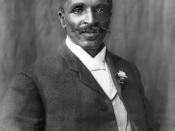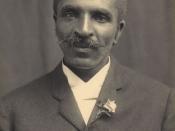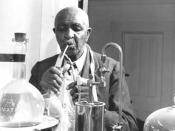George Washington Carver was born on a Missouri farm near Diamond Grove, Newton County in Marion Township, Missouri. He received a B.S. from the Iowa Agricultural College in 1894 and a M.S. in 1896. He became a member of the faculty of Iowa State College of Agriculture and Mechanic Arts in charge of the school's bacterial laboratory work in the Systematic Botany department. His work with agricultural products developed industrial applications from farm products, called chemurgy" in technical literature in the early 1900s. His research developed 325 products from peanuts, 108 applications for sweet potatoes, and 75 products derived from pecans. He moved to Tuskegee, Alabama in 1896 to accept a position as an instructor at the Tuskegee Normal and Industrial Institute and remained on the faculty until his death in 1943. His work in developing industrial applications from agricultural products derived 118 products, including a rubber substitute and over 500 dyes and pigments, from 28 different plants.
He was responsible for the invention in 1927 of a process for producing paints and stains from soybeans, for which three separate patents were issued. George Washington Carver was honored by U.S. President Franklin Delano Roosevelt in July 14, 1943 dedicating $30,000 for a national monument to be dedicated to his accomplishments. The area of Carver's childhood near Diamond Grove, Missouri has been preserved as a park, with a bust of the agricultural researcher, instructor, and chemical investigator. This park was the first designated national monument to an African American in the United States. George Washington Carver was bestowed an honorary doctorate from Simpson College in 1928. He was made a member of the Royal Society of Arts in London, England. He received the Spingarn Medal in 1923, which is given every year by the National Association for the Advancement of colored...


